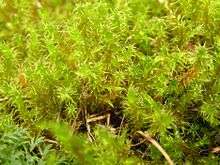Rhytidiadelphus squarrosus
| Rhytidiadelphus squarrosus | |
|---|---|
 | |
| Scientific classification | |
| Kingdom: | Plantae |
| Division: | Bryophyta |
| Class: | Bryidae |
| Order: | Hypnales |
| Family: | Hylocomiaceae |
| Genus: | Rhytidiadelphus |
| Species: | R. squarrosus |
| Binomial name | |
| Rhytidiadelphus squarrosus (Hedw.) Warnst. | |
| Synonyms [1] | |
|
Hypnum squarrosum Hedw. | |
Rhytidiadelphus squarrosus is a species of moss known as springy turf-moss in the United Kingdom,[2][3] and square goose neck moss in the United States.[1][4] It is widespread in Eurasia and North America, and has been introduced to the Southern Hemisphere. It has broad ecological tolerances, and is usually found in man-made habitats such as lawns and golf courses. It is most closely related to R. subpinnatus, with which it is often confused.
Description
Rhytidiadelphus squarrosus grows as an extensive mat of branching stems, up to 15 centimetres (6 in) tall,[5] sheathed in leaves that are 2–2.5 mm (0.08–0.10 in) long and bend sharply back at a right angle, and thus spread outwards from the stem.[2] The leaf bases are broad and include a pair of short nerves.[2] The plant rarely produces capsules, so most of the species' reproduction is asexual.[6]
Distribution
Rhytidiadelphus squarrosus has a circumpolar distribution in the Northern Hemisphere,[5] being found across much of Eurasia, and parts of North America, including British Columbia, Alaska, Washington, Oregon, Newfoundland and Labrador and Greenland.[1]
It has also been introduced to northeastern North America,[7] Tasmania and New Zealand, where it is now an invasive species.[8] The first specimen to be collected in the Southern Hemisphere was taken in 1974 in Dundas Creek, western Tasmania, but the first published record came the following year, from a golf course in Dunedin on New Zealand's South Island.[6]
Ecology
It tolerates a wide variety of soil conditions, from calcareous grassland to acid heaths. It grows most conspicuously in heavily grazed pastures and on the regularly mown fairways on golf courses,[6] and is the most common moss found in lawns in the United Kingdom.[9] It is almost always found in association with humans, leaving its original habitat unclear; it may have evolved as a plant of coastal meadows.[7]
Taxonomy
Rhytidiadelphus squarrosus was formally named (as Hypnum squarrosum) by Johann Hedwig in his 1801 work Species Muscorum,[1] which is considered the starting point for the nomenclature of most mosses.[10]
Although R. squarrosus and R. subpinnatus have sometimes been considered varieties of a single species, particularly by botanists from the United States,[1] studies using microsatellites show them to be separate.[11] The two are often confused, however, and reports of R. squarrosus may sometimes refer to R. subpinnatus.[7] Indeed, both R. subpinnatus and R. japonicus were originally described as infraspecific taxa within R. squarrosus.[1]
In contrast to R. triquetrus and R. loreus, R. squarrosus, R. subpinnatus and R. japonicus have leaves which are not pleated. R. squarrosus differs from R. japonicus in having a long point at the leaf tips, and from R. subpinnatus in the closer spacing of the leaves on the stem, such that the stem can only be seen through the bases of the leaves; in R. subpinnatus, parts of the stem are visible directly.[1]
A new genus, Rhytidiastrum, has been proposed for a group of species including R. squarrosus and R. subpinnatus, but not R. triquetrus.[1]
Etymology
The genus name Rhytidiadelphus derives from the words Rhytidium and ἀδελφός (adelfós, brother), implying a close relationship to the genus Rhytidium.[1] The specific epithet squarrosus refers to the leaves, which are squarrose, having a right-angled bend which causes the tips to extend away from the stem.[1]
References
- 1 2 3 4 5 6 7 8 9 10 Joseph R. Rohrer (2008). "XXX. Hylocomiaceae". Bryophyte Flora of North America, Provisional Publication. Missouri Botanical Garden.
- 1 2 3 Martin Godfrey (2010). "Rhytidiadelphus squarrosus". In Ian Atherton; Sam Bosanquet; Mark Lawley. Mosses and Liverworts of Britain and Ireland: A Field Guide (PDF). British Bryological Society. p. 818. ISBN 978-0-9561310-1-0.
- ↑ R. G. Woods. "The lower plants of Cwm Rhaeadr Forest". Cilycwm.com. Retrieved February 25, 2010.
- ↑ "Rhytidiadelphus squarrosus". Integrated Taxonomic Information System.
- 1 2 Patrick Lilley (2006). "Rhytidiadelphus squarrosus (Hedw.) Warnst.". Bryophytes of Stanley Park. University of British Columbia. Retrieved February 25, 2010.
- 1 2 3 "Bryogeography: imports and exports". Australian Bryophytes. Australian National Botanic Gardens, Australian National Herbarium. Retrieved February 25, 2010.
- 1 2 3 Norton G. Miller (2009). "Mosses adventive and naturalized in the northeastern United States: new examples and new distributional records". Rhodora. 111 (946): 218–230. doi:10.3119/08-7.1.
- ↑ "Distribution, reproductive biology and population studies of the introduced moss Rhytidiadelphus squarrosus". University of Tasmania. Retrieved February 25, 2010.
- ↑ Alan Hale. "Rhytidiadelphus loreus". Mosses and liverworts in Wales. Archived from the original on April 7, 2008. Retrieved February 25, 2010.
- ↑ J. McNeill; F. R. Barrie; H. M. Burdet; et al., eds. (2006). International Code of Botanical Nomenclature (Vienna Code). Regnum Vegetabile 146. Gantner Verlag KG. ISBN 3-906166-48-1.
- ↑ H. Korpelainen, V. Virtanen, K. Kostamo & H. Karttunen (2008). "Molecular evidence shows that the moss Rhytidiadelphus subpinnatus (Hylocomiaceae) is clearly distinct from R. squarrosus". Molecular Phylogenetics and Evolution. 48 (1): 372–376. doi:10.1016/j.ympev.2008.04.007. PMID 18501641.
External links
 Data related to Rhytidiadelphus squarrosus at Wikispecies
Data related to Rhytidiadelphus squarrosus at Wikispecies Media related to Rhytidiadelphus squarrosus at Wikimedia Commons
Media related to Rhytidiadelphus squarrosus at Wikimedia Commons
